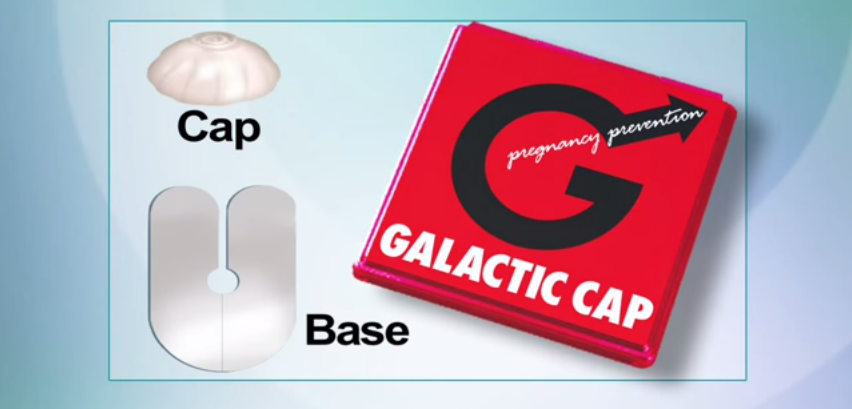Charlie Powell believes the Galactic Cap can change the world.
It’s a condom, kind of — a contoured, adhesive-backed patch of two-ply medical polyurethane, precisely shaped to stick to the head of a penis. It’s designed to leave the sensitive skin around the rim of the head and along the shaft exposed, and has a small hole in the bottom layer of plastic that you align with your own hole, so semen can escape into the reservoir between the plies. Powell likens its shape to a fireman’s hat, but it looks more futuristic than that, like a sci-fi space helmet, for just the tip.

After three years, a snub from Bill Gates, a $100,000 Indiegogo campaign, multiple tweaks and extensive testing with a state-funded sex machine, a non-FDA-approved prototype Galactic Cap is now available online for $25 a Cap (or $15, if you buy in bulk). Based on glowing, anonymous customer surveys, Powell likes to call it “the finest condom in the world.”
He should know. He’s a former corporate video producer (and before that, oil rig roughneck and Vietnam artillery officer) who lives in the semi-industrial suburb of Torrance, CA. And he invented the thing.
The classic innovation story starts with a eureka, a flash of genius, a sidewalk collision of peanut butter and chocolate. Powell’s is a little more like a 20-year train of thought, steadily accelerating into an adhesive dick-helmet future.
The idea of a new condom first took root in the ‘80s, when an editor that Powell had been working with in his video production business contracted HIV.

“That was a death sentence at the time, and it shocked me. Like, Jesus Christ, you’re gonna die from having unprotected sex?”
The friend lived, after starting early antiretroviral therapy, but the condom concept stuck with Powell, especially after he looked into the numbers. Since the beginning of the epidemic, the best estimates say that HIV has killed 35 million people; another 37 million are living with the virus. Condoms remain the most effective way to control the spread of HIV, but only 5 percent of men worldwide regularly use them (though the numbers are much higher in the US). Plus, there’s “unwanted teenage pregnancy, overpopulation, the world’s running out of resources.”
But he understood the multitudes of men who don’t use condoms. “I don’t like them,” he says, “and I never even used one until I was 33.” To increase condom usage, he figured, we needed a condom that even a young Charlie would want to use. He filed the thought away, and continued on with his life.

Then, in 2011, Powell decided it was time to take on something big. After 25 years in film and video production, he was looking for a new business idea, one that could scale. He had recently made a workplace safety training video for a nursing home that he’d then been able to sell, for $125 a copy, to national hospital chains. “I’d make $30,000 on a phone call, because the video was already produced — you know who made three times as much money as Stephen Spielberg? Jerry Seinfeld. Reruns. It made me entrepreneurial. It emboldened me.”
So he called up a Hollywood prop guy, had him mock up some prototypes of the first Galactic Cap (they looked a lot like baby bottle nipples), and started looking for investors to help develop the tech. “My wife thought I was absolutely crazy,” Powell says.
A year and a half later, the Gates foundation announced a new Global Grand Challenge competition for “Next Generation Condom” proposals. “I felt like we were a cinch to get it,” Powell says. “I was horrified when we didn’t.”
The Cap was rejected. The goal of the Gates competition was to come up with a condom that would cut down on HIV transmission by making traditional condoms more pleasant to use while still minimizing skin-to-skin contact. The very premise of the Galactic Cap is to maximize skin-to-skin contact while still keeping semen wrapped up tight.

The selection committee was right that, in a head-to-head STI prevention battle, the Galactic Cap’s intentionally skimpy coverage would lose out to the full-body sheath of a traditional (or slightly tweaked) condom. But Powell believes that this argument rests on faulty logic.
“If it’s not skin-to-skin, guys won’t want to use it,” he says. “They just rearranged the deck chairs on the Titanic.” Powell believes that the increased pleasure of the Galactic Cap will “drastically increase” the number of men worldwide willing to wrap up — and even if the Cap is less effective than a traditional condom at preventing STI transmission, it’s a lot better than wearing nothing at all.
This is a statistical argument about a worldwide population that barely uses condoms, an argument that reducing risk for a larger pool of people is better than ensuring total safety for a relatively tiny population. But on an individual level, Powell concedes that, “if you’re worried about HIV, you need to put on a full condom.”
The adhesive used to attach the cap to the glans is also vulnerable to lube — Powell’s official recommendation is that the Caps only be used with saliva or vaginal fluid, to prevent slipping off. Anal might not be the best use of the Galactic Cap, either.

“It’s really a condom for couples,” Powell says at one point. Despite his having been inspired by his gay friend’s HIV infection, the Cap is best suited for straight sex. This doesn’t seem to faze him, though — he believes in the statistical argument, vehemently, and repeats that he’s motivated by a desire to “reduce this terrible disease.”
So, undeterred by the Gates rejection and convinced that the world needs the Galactic Cap, Powell took the idea to the public. His Indiegogo campaign picked up a bunch of amused press and brought in $100,557. His wife, he says, was now on board.
There was a problem, though — the prototype pictured in the Indiegogo campaign didn’t really work all that well. The low-profile ring keeping the Cap in place wasn’t big enough to properly stick around.

So Powell did what anyone would do: “I got my handyman, who was working around my house, and we sat down with a dildo and we made this thing.”
The new and improved design came in one piece, with a longer anchor extending down from the bottom of the head to keep it in place — the fireman’s hat, longer in the back. It’s made of an FDA-approved polyurethane film not unlike 3M’s Tegaderm, the soft, thin plastic often used to anchor IV needles to hospital patients’ skin, and uses an FDA-approved adhesive. Now it just needed FDA approval. And some science.
To that end, Powell got in touch with the mechanical engineering department at nearby California State University, Long Beach. “I said, Look I’d like to endow the university,’ and they put me in touch with the dean.” The endowment was just a ruse to get in the door, but Powell says, “if the thing flies, and it’s mega big, which I think it will be, then it wouldn’t be any problem to give them a million dollars or whatever.”

He proposed a collaboration, and found Assistant Professor of Mechanical and Aerospace Engineering David Stout. “I thought it was really cool — the design of condoms hasn’t changed since we first started using them,” Stout says, “and they kind of suck. They really do.”
Stout went to work on testing the strength of the Galactic Cap’s materials, and enlisted some students to help on the project. The first task: building the sex machine.

“We got a fleshlight, then we had to buy a dildo, and my student had to go into a machine shop and custom-machine all of the parts,” Stout says. The goal was to exactly mimic the friction and heat produced by vigorous lovemaking. The hardest part was securing the dlldo to the thrusting rod. (“It kept getting stuck in the vagina.”) Simulating ejaculation, on the other hand, was surprisingly simple.
“We burned holes through dildos, drilled holes through dildos,” Stout says. “Then you just put a tube in and attach it to a syringe, and then — we use a kind of snot base, like an alginate or gel — you press the plunger and it goes like a balloon.”
“It’s a lot of fun getting a chuckle out of people,” Stout added. “They can see what their tax dollars are going to.”
The material, Stout found, was surprisingly elastic, and the adhesive surprisingly strong. The Cap could even hold a full bladder’s worth of pee simulator without falling off.

(This led Stout to come up with a possible secondary application of the Galactic Cap’s technology, one which he’s currently applying for an NIH grant to study. Now, men who find themselves stuck immobilized, whether at home or in hospitals, have to have a catheter inserted into their urethras so they can pee into a bag. In some cases of high infection risk or non-standard anatomy, however, the solution is surprisingly primitive. “We just put a condom right on somebody’s penis so they can relieve themselves, but the problem is they aren’t adhesive,” Stout says, “so if an individual has a flaccid penis, it often falls off, and then patients end up peeing on themselves. It’s really sad, a traumatic event for a lot of people.” Powell says “that’s a secondary application — I think the market is much bigger for condoms.”)
FDA approval, however, requires more than just a sex machine. Powell says that the clinical trials necessary to prove to the regulators that the Galactic Caps are a safe and effective method of birth control and STI prevention could cost up to a million dollars.

Assuming he can afford those tests, though, the production pipeline is in place. “It’s a rocket on the launchpad; it’s ready to go. It just needs capital investment.”
And Powell’s optimistic. “The thing about the future is it’s hard to see, right? I think I see the future. I think the future is this thing.”

He has only one regret: calling the Galactic Cap the Galactic Cap.
“It needed to be catchier, like the Galactic Prophylactic. When I was making the Indiegogo video, I went to the dictionary and I came up with galactic, because it was pleasure that was out of this world, and then it was kind of capping the head of the penis,” Powell says. “But it needs a little more sizzle.”
